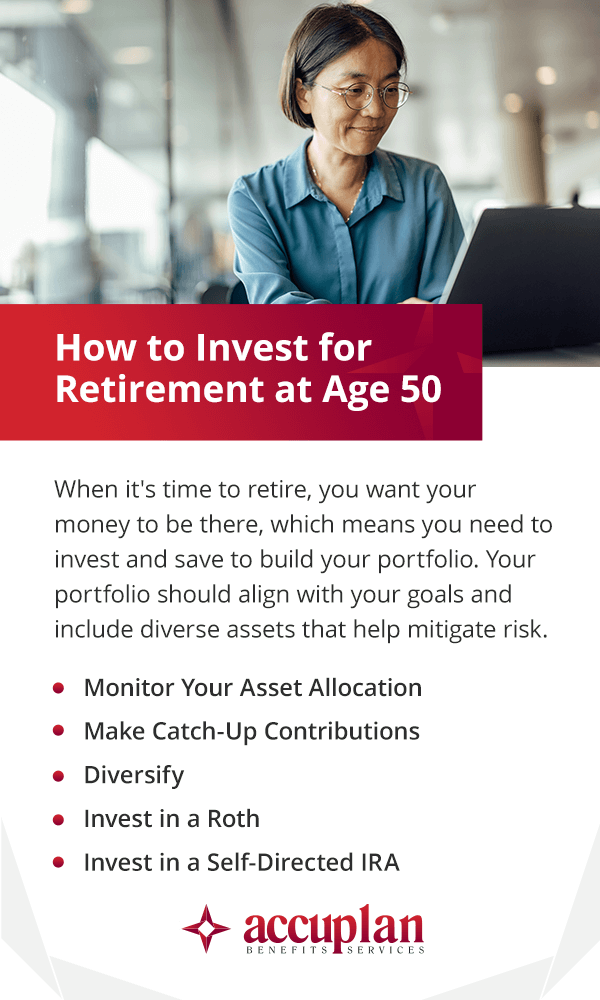
In your 20s, 30s and maybe even your 40s, retirement can feel like a distant reality. In your 50s, the horizon is beginning to inch closer. As such, it can be one of the most important decades for financial planning and developing a retirement savings plan. If you find you aren’t quite where you want to be, it’s not too late. You can take steps in your 50s to get your savings and investing goals back on track.
Whether you’ve been saving large annual sums for decades or are just starting your retirement savings, you need to understand the best ways to save for retirement in your 50s. With some financial planning and investment strategy, you can have the golden years you hope for. As you enter your 50s, you may want to set some financial goals for this next decade of your life, build wealth and invest for the retirement of your dreams.
Financial Goals in Your 50s
Your 50s are a great time to reassess. Evaluate your short-term and long-term goals, figure out where you are financially and determine how you can get where you want to be. Make sure your goals are realistic and align with your lifestyle.
1. Review Your Progress Toward Retirement Savings
Now is the time to assess your current progress in saving for retirement. Review how much you have invested, calculate the amount of income you may be able to generate during retirement and list your expenses. At this point, if you’re projecting a shortfall, you can restructure your plan and get back on track. Getting on track could involve cutting expenses or saving more.
Regularly review your plan for retirement savings to ensure you’re making progress. You may want to use a retirement planning checklist to stay on track and assess your progress at least once a year.
2. Use a Taxable Account to Supplement Savings
You may also want to consider saving some of your funds in a taxable account. When you set money aside in a taxable account, you can improve your retirement funds’ tax diversification and save for different goals. If your retirement savings are on track, it may be beneficial to put your next dollar into a taxable account rather than a tax-deferred account.
3. Prioritize Your Career

Your ability to earn an income is one of your greatest assets. In your 50s, you may want to prioritize your career and focus on finding work you enjoy. When you enjoy your work, you may decide to stay in the workforce longer, which can benefit your retirement years.
While you work, you continue paying into Social Security, which could potentially increase your benefits. Since Social Security benefits are based on your average indexed earnings over a certain number of years when you earned the most, working longer in your peak earning years can offset the years when you earned less. If you want additional income outside of your day job, you may want to monetize a hobby you enjoy or utilize a skill to build another income stream.
4. Plan for Long-Term Care
Though you may not be thinking about your long-term care right now, it can still be a great time to make your plans. Long-term care can be costly, so you should factor it into your plan for retirement savings by 50.
Consider reviewing your option for long-term care insurance and making your purchase now. As you get older, it can become more difficult to qualify for this coverage, so planning for this in your 50s can ensure the coverage you may need.
Why Plan for Retirement in Your 50s
You should plan for retirement in your 50s, as this may be your last full decade to save and invest for retirement. If you plan to retire in your 60s, now is the time to ensure your plans are on track or if you need to reevaluate your plans. The following are some of the benefits of planning for your retirement:
- Lower your taxes
- Reduce your stress levels with fewer financial strains
- Support any children and grandchildren
- Avoid running out of money when you retire
- Handle forced early retirement with ease if necessary
- Use your goals to make better financial and career decisions
Planning for retirement can ensure you’re set to meet your savings goal. To get on track, you may want to increase your savings rate or plan to work longer before retiring.
How Much Retirement Should I Have at 50?
A good rule of thumb for your total retirement savings is to have at least 25 times what you want to spend every year of your retirement. For example, if you want to spend $50,000 a year, you should have $1,250,000 saved by the time you hit retirement age. Of course, this rule of thumb doesn’t account for the specifics of your financial situation. If you want to include a pension or Social Security in your retirement planning, this could lower the amount of money you need to save on your own.
You may want to have between eight to 15 times your annual salary saved for retirement before you reach your 60s. If you earn $100,000 a year, for example, this means you should have between $800,000 and $1,500,000 saved. If you want to calculate an amount more closely aligned with your goals and circumstances, factor in the spending power you want in retirement, the age at which you plan to retire and other streams of income you may have.

4 Tips for How to Build Wealth in Your 50s
Along with setting financial goals and planning for retirement, now is the time to start building wealth. Follow the tips below to build wealth in your 50s.
- Cut your spending: One way you can build wealth in your 50s is by cutting your spending. Spending less can help you save more, so you may want to cut down your lifestyle a little to live more lavishly in your retirement years. If you choose to keep your lifestyle more minimal throughout retirement, you can save less while maintaining your standard of living. Analyze your budget to determine where you can reduce your spending.
- Pay down debt: After you pay off your credit cards and other consumer debt, such as car loans or student loans, you may want to focus on paying off your mortgage. When you don’t have to make mortgage payments, you can focus on investing and saving for other major financial goals like retirement. Paying off your mortgage can be a significant financial hurdle, but it can be worth it in the long run, especially if you want to reduce your expenses in retirement.
- Generate additional income streams: Another way you can build wealth in your 50s is by generating additional income streams. While you can use your investments as an income stream in retirement, you may also be able to generate passive income streams that continue bringing in money during your golden years. Consider starting a side hustle or freelancing, especially if you are behind on investing for retirement in your 50s.
- Save for emergencies: If you don’t already have an emergency fund, now is the time to start saving. You want to avoid dipping into your retirement funds for emergencies, as you may need to pay a penalty for early withdrawals. Withdrawing from your retirement accounts could also throw off your financial planning.

How to Invest for Retirement at Age 50
When it’s time to retire, you want your money to be there, which means you need to invest and save to build your portfolio. Your portfolio should align with your goals and include diverse assets that help mitigate risk.
1. Monitor Your Asset Allocation
An investment portfolio for a 50-year-old should keep pace with inflation, which means maintaining a moderate-risk portfolio. Going too conservative with your investments could mean your portfolio doesn’t keep up with inflation, and you could actually lose spending power. At this point in your life, a majority of your investments should be in equities, and the other portion should be invested in fixed income. With a 401(k) plan, you can set up automatic rebalancing so your asset allocation adjusts accordingly as you approach retirement.
Since retirement can last a few decades, you need your portfolio to continue growing to support you. Even in retirement, your asset allocation should include exposure to stocks. However, since stocks are more vulnerable to short-term risks and you may need to access your assets for income, you should also add more exposure in your portfolio to cash and bonds.
2. Make Catch-Up Contributions
Investing in your 50s is especially important if you haven’t started saving for retirement yet. Luckily, you still have time to get on track with catch-up contributions. Once you’re in your 50s, you can begin making additional contributions to tax-sheltered retirement accounts, meaning your contribution limit is higher than in previous decades of your life, and you can take these years to save more.
If permitted by your 401(k) plan, when you hit 50, you can save up to $6,500 in catch-up contributions. The contribution limit for 401(k) plans is $61,000, or a total of $67,500 if you make catch-up contributions. For both traditional and Roth IRAs, the contribution limit when you’re in your 50s is $7,000. Qualified reservist repayments and rollover contributions do not apply to the IRA contribution limit.
Additionally, if you have multiple 401(k) plans from different employers, consider putting them in a single plan to maximize growth. Select a plan with the lowest fees. Doing so can help you track your savings and investments more easily.
3. Diversify
An investment portfolio for a 50-year-old should be diversified to mitigate risk and get the best return over the long term. You can invest in more asset classes and diversify your money within asset classes. For equities, you should have exposure to real estate, emerging and established international markets and small, mid-size and large companies. For bonds, you should allocate your money to long-term, mid-term and short-term U.S. and international assets.
If you are a DIY investor, you can invest in exchange-traded funds (ETFs), index mutual funds and individual stocks. However, working with an expert can help you diversify and manage your portfolio to ensure you reach your goals.
4. Invest in a Roth
A Roth IRA offers tax-free withdrawals, whereas a traditional IRA has tax-deductible contributions, but withdrawals are taxed. Younger investors tend to favor the Roth IRA, but this retirement investment tool is also valuable in your 50s. When you invest in a Roth IRA, you can enjoy greater flexibility later when you want to withdraw money and leverage different tax treatments.
If you have a Roth IRA, continue making contributions to this account. If not, you may want to open one if you qualify and start making contributions. During lower income years, you may also want to consider a Roth conversion. If you need a greater amount of income but don’t want to increase your taxable income, you can withdraw from your Roth account.
Roth IRAs do not mandate required minimum distributions, so if you don’t need your money, you can leave the funds to keep growing tax-free. Additionally, a Roth IRA is gentler when it comes to taxes and passing your money to your heirs. If you do not qualify for a Roth IRA, you can instead contribute to a Roth 401(k) if offered by your employer. Consider dividing your contributions between both traditional and Roth accounts to invest for retirement.
5. Invest in a Self-Directed IRA
To diversify your portfolio and invest in a wider variety of assets, you may want to open a self-directed IRA. With this IRA, you can invest in alternative assets that you cannot invest in with conventional retirement accounts. Some alternative assets you may want to consider investing in with a self-directed IRA include:
- Cryptocurrencies
- Loans
- Private lending
- Rental properties
- Private equity
- Precious metals like gold, platinum, silver and palladium
With a self-directed IRA, you enjoy the same tax advantages you would get from a standard IRA.

Learn More About How to Prepare for Retirement in Your 50s With a Self-Directed IRA
Financial planning for 50-year-olds involves saving for retirement and other financial goals. A self-directed IRA can help you invest in alternative assets, such as precious metals, real estate and private equity. With this type of IRA, you can diversify your portfolio better than when limited to more conventional asset classes like stocks and mutual funds.
At Accuplan, we are a leading provider of self-directed IRA administration, and our platform is built for both individual investors and businesses. Our services and dedicated experts have been integral to the success of thousands of investors. If you are looking to invest for your financial future and retirement, contact Accuplan to learn more about financial planning in your 50s and how to invest.
Our information should not be relied on for investment advice. Our content is simply for educational and informational purposes only. Our information is not meant to provide, nor should it be depended on for investment, accounting, tax or legal advice.